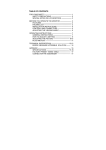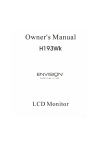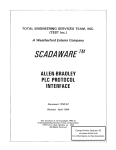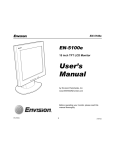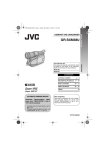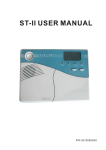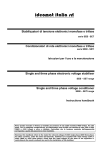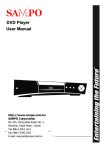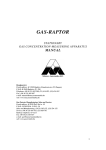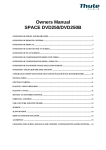Download Memorex MM1740 User's Manual
Transcript
TABLE OF CONTENTS User's Manual 17” LCD MONITOR FOR YOUR SAFETY---------------------------------------------- 1 SAFETY PRECAUTIONS -------------------------------------- 2 SPECIAL NOTES ON LCD MONITORS -------------------------- 3 BEFORE YOU OPERATE THE MONITOR ---------------------------- 3 FEATURES -------------------------------------------------- 3 PACKING LIST --------------------------------------------- 4 OPERATING INSTRUCTIONS -------------------------------------- 4 GENERAL INSTRUCTIONS ------------------------------------ 4 HOW TO ADJUST A SETTING---------------------------------- 6 ADJUSTING THE PICTURE ----------------------------------- 7 HOW TO OPTIMIZE THE DOS-MODE ---------------------------- 8 PLUG AND PLAY -------------------------------------------TECHNICAL SUPPORT(FAQ) 9 ----------------------------------------10 ERROR MESSAGE AND POSSIBLE SOLUTION -------------------- ---11 APPENDIX --------------------------------------------------------12 SPECIFICATIONS------------------------------------------------------------------- -----12 FACTORY PRESET TIMING TABLE---------------------------------14 CONNECTOR PIN ASSIGNMENT ---------------------------------14 Please read the user’s manual carefully before using the monitor 1 Before operating the monitor please read this manual thoroughly. This manunl should be retained for future reference. FCC Class B Radio Frequency Interference Statement WARNING:(FOR FCC CERTIFIED MODELS) NOTE:This equipment has been tested and found to comply with the limits for a Class B digital device, pursuant to Part 15 of the FCC Rules. These limits are designed to provide reasonable protection against harmful interference in a residential installation. This equipment generates, uses and can radiate radio frequency energy, and if not installed and used in accordance with the instructions, may cause harmful interference to radio communications. However, there is no guarantee that interference will not occur in a particular installation. If this equipment does cause harmful interference to radio or television reception, which can be determined by turning the equipment off and on, the user is encouraged to try to correct the interference by one or more of the following measures: 1.Reorient or relocate the receiving antenna. 2.Increase the separation between the equipment and receiver. 3.Connect the equipment into an outlet on a circuit different from that to which the receiver is connected. 4.Consult the dealer or an experienced electric technician for help. NOTICE 1.The changes or modifications not expressly approved by the party responsible for compliance could void the user’s authority to operate the equipment. 2.The manufacturer is not responsible for any radio or TV interference caused by unauthorized modification to this equipment. It is the responsbilities of the user to correct such interference. PRECAUTIONS ?? Do not use the monitor near water, or lay it at a moisture place. ?? Openings in the back of the cabinet are provided for ventilation. To ensure reliable operation of the monitor and to protect it from overheating,be sure these openings are not blocked or covered. ?? The monitor should be operated only from the type of power source indicated on the label. If you are not sure of the type of power supplied to your home, consult your dealer or local power company. ?? Unplug the unit during a lightning storm or when it will not be used for long periods of time. This will protect the monitor from damage due to power surges. ?? Do not overload power stripd and extension cords. Overloading can result in fire or electric shock. ?? Do not attempt to service the monitor yourself,opening or removing covers can expose you to dangerous voltages and other hazards. Please refer all servicing to qualified service personnel. ?? To ensure satisfactory operation, use the monitor only with UL listed computers which have appropriate configured receptacles marked between 100-240V AC, Min, 1.0A. ?? The wall socket shall be installed near the equipment and shall be easily accessible. WARNING: To prevent fire or shock hazard, do not expose the monitor to rain or moisture. Dangerously high voltages are present inside the monitor. Do not open the cabinet. Refer servicing to qualified personnel only. 1 2 2 SPECIAL NOTES ON LCD MONITORS The following symptoms are normal with LCD monitor and do not indicate a problem. POWERCORD Power Source: 1.Make sure the power cord is the correct type that required in your area. 2.This LCD monitor has a universal power supply that allows operation in either 100/120V AC or 220/240V AC voltage area(No user adjustment is required.) 3.Connect the AC-power cord into your LCD monitor's External Adapter input socket, and then plug the other end of External adapter to LCD monitor’s DC-power-input. The AC-power cord may be connected to either a wall power outlet or the power outlet socket on your PC, depending on the type of power cord supplied with your LCD monitor. CONTROLS AND CONNECTORS VIDEO CABLE Connecting the Video Cable: the LCD monitor comes with a built-in video cable. Plug the signal cable's 15-pin connector into the computer is video port and tighten the two screws on the cable connector. Connecting the Power Cord: Plug the AC-power cord into the External Adapter. Then plug the DC-jack power cable into DC-IN Inlet. Caution: If the AC outlet is not grounded, install the proper grounding adapter(not supplied). NOTES ?? Due to the nature of the fluorescent light, the screen may flicker during initial use. Turn off the Power Switch and then turn it on again to make sure the flicker disappears. Or you can use of AUTO function. ?? You may find slightly uneven brightness on the screen depending on the desktop pattern you use. ?? The LCD screen has effective pixels of 99.99% or more. It may include blemishes of 0.01% or less such as a missing pixel or a pixel lit all of the time. ?? Due to the nature of the LCD screen, an afterimage of the previous screen may remain after switching the image,when the same image is displayed for hours. In this case, the screen is recovered slowly by changing the image or turning off the Power Switch for hours. ?? The life of the fluorescent light used in the LCD moniter is approximately 50,000 hours. Contact your dealer for replacement when the screen is dark, flickeing or not lighting up. Never attempt to replace it by yourself. BEFORE YOU OPERATE THE MONITOR FEATURES ?? 43.2cm(17?) TFT Color LCD Monitor ?? Crisp, Clear Display for Windows ?? Recommened Resolutions:1280X 1024 @75Hz ?? EPA ENERGY STAR ?? Space Saving, Compact Case Design CHECKING THE CONTENTS OF THE PACKAGE The product package should include the following items: 1.LCD Monitor 5? Video cable 2.Owner's Manual 6. DVI cable 3.Power Cord 7.Audio cable 4.Adapter 8. warranty card OPERATING INSTRUCTIONS GENERAL INSTRUCTIONS Press the power switch to turn the monitor on or off. The other control knobs are located at front panel of the monitor. By changing these settings, the picture can be adjusted to your personal preferences. ?? The power cord should be connected. ?? Connect the video cable from the monitor to the video card. ?? Press the power switch to turn on the monitor position. The power indicator LED will light up. 3 4 3 FRONT PANEL CONTROL HOW TO ADJUST A SETTING 1.Press the MENU button to activate the OSD window. See figure 5. 2.Press ? or? to select the desired function. 3.Press the MENU button to select the function that you want to adjust. 4.Press? or? to change the settings of the current function. 5.To exit and save, select the exit functions, or leave the monitor alone for 15 seconds. If you want to adjust any other function, repeat steps 2-4. 6.When the OSD window is active, it shows the input signal timing. ?? Power Key: Press this button to switch ON/OFF of monitor's power. ?? MENU/Enter: Activates the OSD menu or function adjust confirm . ?? Contrast: Adjust contrast or function adjust. ?? Brightness: Adjust brightness or function adjust. ?? Auto Adjust Key/Exit: When OSD menu is in off status, press this button direct to activate the Auto Adjustment function. The Auto Adjustment function is used to set the HPos,VPos, Clock and Focus ?? Power Indicator: green ---- Power On mode. orange ---- Off mode. ADJUSTING THE PICTURE The description for function control LEDS 1 Colour 1.1 Contrast Adjust the picture contrast. 1.2 Brightness Adjust the picture brightness. 1.3 Colour Temp 9300/6500/User The color temperature for 6500k is x =0.313,y =0.329 and 9300k is x =0.281, Y =0.311. It presents two different color sets on the screen. You can select 9300K or 6500K by pressing MENU Key. If the 9300K normal white or 6500K warmer white do not satisfy your desire, properly adjust R.G.B GAIN controls to obtain your optimum whiteness level. 1.4 Colour Adjust User the adjust red/green/blue intensity 1.5 Exit 2. Picture 2.1 H. Position Adjust the horizontal position of the picture. 2.2 V. Position Adjust the vertical position of the picture. 2.3 Phase Adjust the picture Focus. 2.4 Clock Adjust the picture Clock. 2.5 Sharpness Adjust the words sharpness. NOTES ?? Do not install the monitor in a location near heat sources such as radiators or air ducts, or in a place subject to direct sunlight, or excessive dust or mechanical vibration or shock. ?? Save the original shipping carton and packing materials, as they will come in handy if you ever have to ship your monitor. ?? For maximum protection, repackage your monitor as it was originally packed at the factory. ?? To keep the monitor looking new, periodically clean it with a soft cloth. Stubbrn stains may be removed with a cloth lightly dampened with a mild detergent solution. Never use strong solvents such as thinner, benzene, or abrasive cleaners, since these will damage the cabinet. As a safety precaution, always unplug the monitor before cleaning it. 5 4 2.6 Exit 3. Function 3.1Auto Adjust Reset to original factory geometry setting 3.2Auto Colour Reset to original factory color setting 3.3Exit Adjust the picture Focus. 4. OSD Menu 4.1 Language Muti-Language selection. Chinese / English / French / German / Italian / Spanish / Japan 4.2 OSD H. Pos. Adjust the horizontal position of the menu. 4.3 OSD V. Pos. Adjust the vertical position of the menu 4.4 OSD Timer Adjust Menu appear Time. 4.5 Exit 5. Misc 5.1Signal Source In pout VGA or DVI. 5.2 Mode Select 640×400 / 720×400 640×400 and 720×400 of DOS mode. 5.3 Reset Reset to original factory color and geometry setting. 5.4 Volume Adjust the volume just. 5.5 Exit 6. Exit 2.Press”AUTO”button(at front pane) about 2 seconds, the monitor will do all the adjustment automatically. You can adjust the image manually, If the screen has a flicker or blur, or not fit in the display 3.press ALT-F, and then X to exit from the Dos-Editor screen If the DOS-MODE characters still have distortion example: ?? The picture can't go to full screen ?? The background of white pattern has vertical stripe noise ?? The character twisted That means your monitor parameter was in wrong resolution, please check if your VGA-CARD supports 720x400@70Hz In general, most of the Dos mode was set by VGA-CARD in resolution 720x400@70Hz , but minor was set in 640x400@70Hz PLUG AND PLAY Plug & Play DDC1/2B Feature This monitor is equipped with VESA DDC1/2B capabilities according to the VESA DDC STANDARD. It allows the monitor to inform the host system of its identity, and depending on the level of DDC used, communicate additional information about its display capabilities. The communication channel is defined in two levels, DDC1 and DDC2B. The DDC1 is a unidirectional data channel from the display to the host that continuously transmits EDID information. The DDC2B is a bidirectional data channel based on the I2C protocol. The host can request EDID information over the DDC2B channel. THIS MONITOR WILL APPEAR TO BE NON-FUNCTIONAL IF THERE IS NO VIDEO INPUT SIGNAL. IN ORDER FOR THIS MONITOR TO OPERATE OPERATE PROPERLY, THERE MUST BE A VIDEO INPUT SIGNAL. HOW TO OPTIMIZE THE DOS-MODE This monitor meets the Green monitor standards as set by the Video Electronics Standards Association(VESA) and/or the United States Environmental Protection Agency(EPA) and The Swedish Confederation Employees(NUTEK). This feature is designed to conserve electrical energy by reducing power consumption when there is no video-input signal present. 1.Get the full screen pattern at MS-DOS mode, type in C:\>EDIT [press enter] You will be in the Dos-Editor screen 5 When there is no video input signal this monitor, following a time-out period, will automatically switch to an OFF mode. This reduces the monitor's internal power supply consumption. After the video input signal is restored, full power is restored and the display is automatically redrawn. The appearance is similar to a “Screen Saver” feature except the display is completely off. The display is restored by pressing a key on the keyboard, or clicking the mouse. Missing one of the primary colors(RED,GREEN,or BLUE) Screen image is not centered or sized properly. Picture has color defects (white does not look white) Poor brightness or contrast TECHNICAL SUPPORT(FAQ) Problem & Question Power LED is not on No Plug & Play Picture is fuzzy Picture bounces or a wave pattern is present in the picture The power LED is ON(orange) but there's no video or no picture. Possible Solution Check if the Power Switch is in the ON position Power Cord should be connected Check if the PC system is Plug & Play compatible Check if the Video Card is Plug & Play compatible Check if the D-15 plug pin of Video Cable is bent Adjust the Contrast and Brightness Controls. Move electrical devices that may cause electrical interference. Computer Power Switch should be in the ON position. Computer Video Card should be snugly seated in its slot Make sure monitor's video cable is properly connected to the computer. Inspect monitor's video cable and rnake sure none of the pins are bent. Make sure computer is operational by hitting the CAPS LOCK key on the keyboard while observing the CAPS LOCK LED. The LED should either turn ON or OFF after Horizontal or vertical disturbancies on the screen hitting the CAPS LOCK key. Inspect the monitor's video cable and make sure that none of the pins are bent. Adjust pixel frequency(CLOCK) and PHASE or press hot-key (AUTO) Adjust RGB color or select color temperature The life time of the back-light is limited. In 50000 Hours the luminance of the light has been reduced to half of its original value. Please send the monitor to an authorized service Agent for service. Use win 95/98/2000/XP shut-down mode Adjust CLOCK and PHASE or perform hot-key(AUTO-key). CLOCK(pixel frequency) controls the number of pixels scaned by one horizontal sweep. If the frequency is not correct, the screen shows vertical stripes and the picture has not correct width. PHASE adjust the phase of the pixel clock signal. With a wrong phase adjustment the picture has horizontal disturbances in light picture. For PHASE and CLOCK adjustment use “dot-pattern”or win 95/98/2000/XP shut-down mode pattern. 6 ERROR MESSAGE AND POSSIBLE SOLUTION APPENDIX CABLE NOT CONNECTED : SPECIFICATIONS 1.Check that the signal-cable is properly connected , If the connector is loose, tighten the connector’s screws. 2.Check the signal-cable’s connection pins for damage. 640×480 720×400 640×480 640×480 800×600 800×600 800×600 VERTICAL FREQUENCY 60Hz 70Hz 72.8Hz 75Hz 56.3Hz 60.3Hz 72.2Hz RESOLUTION 800×600 1024×768 1024×768 1024×768 1024×768 1280×1024 1280×1024 TFT Color LCD 43cm(17”) 0.264mm(H)×0.264MM(V) 140° (H)130° (V) Response time Video Separate Sync. H-Frequency V-Freauency DVI Display Colors Brightness Contrast Max. Resolution Plug & Play 16ms R,G,B Analog Interface H/V TTL 30kHz-80kHz 55-75Hz DIGITALIN 16M Colors 300cd/m2 450;1 1280×1024 VESA DDC1/2BTM Input Connector Input Video Signal Maximum Screen Size Power Source D-Sub 15pin Analog:0.7Vp -p(standard), 75OHM,Positive Horizontal:380.16mm Vertical:304.1mm 100~240V AC,50~60Hz Environmental Considerations Operating Temp:0° C to 40° C Storage Temp:-20 ° C to 60° C Operating Humidity:10% to 85%. Weight (N.W.) 4.2kg LCD Panel INPUT NOT SUPPORT: Your computer has been set to unsuitable display mode, Set the computer to display mode given in the following table. UNSUPPORTED MODE TRY DIFFERENT VIDEO CARD SETTING: Your computer resolution is out of VESA-SPEC RESOLUTION: RESOLUTION Driving system Size Pixel pitch Viewable angle Input VERTICAL FREQUENCY 75Hz 60Hz 70Hz 75Hz 74.92Hz 60Hz 75Hz 7 Switch External Controls: Functions EPA ENERGY STAR Regulatory Compliance ON Mode OFF Mode 13 ?? Auto Adjust Key/Exit ?? Brightness ?? Contrast ?? Power Key ?? MENU/Enter ?? Brightness ?? Geometry ?? Color ?? Language ?? Auto Adjust ?? Exit ?? Recall <48W(For 4 CCFL) <5W CE,FCC,CCEE 14 FACTORY PRESET TIMING TABLE STANDARD VGA SVGA XGA SXGA RESOLUTION HORIZONTAL FREQUENCY VERTICAL FREQUENCY 720×400 640×480 640×480 640×480 800×600 800×600 800×600 800×600 1024×768 1024×768 1024×768 1280×1024 1280×1024 31.47 kHz 31.469 kHz 37.861 kHz 37.5 kHz 35.156 kHz 37.879 kHz 48.077 kHz 46.875 kHz 48.363 kHz 56.476 kHz 60.023 kHz 64 kHz 80 kHz 70.00 Hz 60.00 Hz 72.00 Hz 75.00 Hz 56.00 Hz 60.00 Hz 72.00 Hz 75.00 Hz 60.00 Hz 70.00 Hz 75.00 Hz 60 Hz 75 Hz CONNECTOR PIN ASSIGNMENT 15-PIN COLOR DISPLAY SIGNAL CABLE PIN NO. 1. 2. 3. 4. 5. 6. 7. 8. 8 DESCRIPTION PIN NO. Red 9. +5V Green 10. Ground Blue 11. Ground Ground 12. DDC-Serial Data Ground 13. H-Sync R-Ground 14. V-Sync G-Ground 15. DDC-Serial Clock B-Ground DESCRIPTION 15 9









